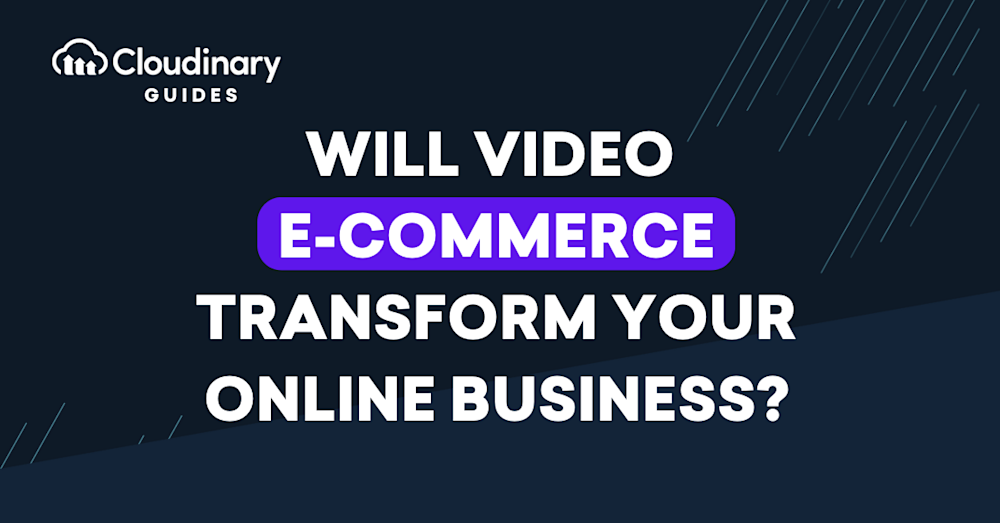Video e-commerce, i.e., marketing video that promotes services and products online, typically includes a link from the feed, sending viewers directly to an e-commerce shop. You can link to e-commerce sites on streaming platforms like YouTube and social networks like Instagram and Facebook. In addition, you can host footage on video e-commerce platforms, such as Amazon Live, or on your retail site.
Many consumers, especially the younger, digital-first ones, speak video as a first language, and e-commerce businesses must do likewise to succeed. Why? Because video is a superb medium for engagement and sharing, correspondingly winning customers and growing revenue.
This is part of a series of articles about Marketing videos.
This article covers the following topics:
Shoppable Videos
Shoppable videos are interactive, product-focused videos, which you create by adding to them interactive elements, e.g., a narrative splash and a storyline. Interactive elements enlighten viewers by prompting them to take action, which might dictate the narrative, revealing a secondary scene running simultaneously alongside the main one. Those elements can also be periodic quizzes or activities, to which viewers must respond or undertake before the video transitions to the next chapter or topic.
Programmed and produced differently from interactive videos slated for e-learning, shoppable videos usually include the following product content:
- Procedures and processes
- Customer testimonials
- Life hacks
- Explainers
- Product features
- Advertisements and commercials
Shoppable videos are highly popular in the fashion industry. With those videos, not only can potential customers view how apparels look on people who are on the go, but they can also make purchases instantaneously by means of interactive features.
For details, see our blog post Whether Browsing Or Buying, Consumers Love Livestream Shopping. Another post, Cloudinary Shoppable Video, describes how to easily create shoppable videos.
Live and Non-Live Video Shopping
Live video shopping, also known as livestream shopping, interacts with the audience, merging shopping and entertainment into one experience. The presenters, responsible for eliciting responses from the audience, are key to success. Specifically:
- Thanks to the live feature, presenters can see in real time viewers’ reactions.
- During one-to-one streaming, presenters can ask shoppers what they want to know or see, and respond accordingly.
- During one-to-many streaming, presenters can pose questions and secure responses through polls and direct messages. Also, the number of people leaving the stream midway would speak to the appeal of the presentation.
Highly scalable and available on demand, non-live video is recorded, tagged, and then integrated into user experiences—on websites, social networks, or video platforms. The main drawback of non-live video is that it assumes what audiences desire to see, which might not be accurate.
For a more in-depth take, read our blog post “Going Live” Gains Popularity in Commerce, Social, and Events.
Benefits of Product Videos for Businesses
Product videos are a boon for e-commerce. Here’s a rundown of the benefits:
- People are more likely to share video than text.
- People are more likely to click a video thumbnail than a text-only element.
- Product videos quickly convey a vast amount of information, including how the product looks in real life.
- Product videos show consumers how to feel about the product.
- Consumers spend more time on webpages that contain videos.
- Consumers prefer watching videos for product information to reading about it.
- Online visitors engage more with pages that contain videos.
- Studies reveal that up to three quarters of consumers are more likely to purchase a product after watching a video on how it works.
- Videos boost confidence in a product, as pointed out by many consumers, who are then less likely to return their purchases.
- Google displays a vast mix of information in search results (videos, images, news, maps), ranking the sites that feature product videos higher and making the sites more visible—especially if your competitor sites do not contain product videos.
- Google prioritizes and places sites that display YouTube-hosted videos higher in search results.
For more insight, see our blog post Product Videos 101: What Makes Them Great.
Incorporation of Video in Your E-Commerce Marketing Strategy
Below are useful tips for developing marketing campaigns with video.
- Post shoppable videos on social networks. Optimize your shoppable videos for all social networks and comply with the guidelines for dimensions, length, and other technical parameters. Also, add subtitles for viewers who prefer to watch videos without sound.
- Spotlight shoppable videos in lead-generation and retargeting ads. Video ads attract viewers and help track view statistics. By serving static image ads at the right moment, you can generate a high return on advertising spend (ROAS).
- Embed shoppable videos in your site. Add videos to your homepage, product pages, FAQs, and About pages to build up the time spent on your site. In particular, videos in FAQs greatly enhance the customer experience.
- Serve videos across the entire customer journey. Feature shoppable videos, including lead-capture forms and exit-intent overlays, throughout the customer visit. Better yet, create and run multiple campaigns across e-commerce verticals.
Best Practices for Video E-Commerce
To make the most of your video content, take the three steps below.
Create a Clear Narrative
Storytelling adds context so be sure to tell a story that highlights the value of the product and the essence of the brand. For example, explain the product’s benefits and the ways in which to optimize its use. Ideally, build the video in such a way that it enables you to continue reiterating your brand’s values and promise.
For more suggestions, read our blog post Three Easy Ways to Improve Video Storytelling.
Keep It Short
Limit product videos to 30 seconds in length, which is especially critical for posting on social networks. The effort and time involved is well spent because it makes those videos look professional. On the other hand, lengthier videos might be necessary to pull the viewer’s heartstrings. Use your best judgment.
Build Relatable Content
To raise the relatability between your brand and its customers through product videos, show emotion and authenticity, for example, in the form of real people or their animated counterparts. Aim at ensuring that potential customers feel understood and important by simply watching the footage.
See also our blog post Tips for Retaining Audience Through Engaging Videos.
Implementation of Video E-Commerce With Cloudinary
Creating and serving video in today’s competitive world, though the new norm for visual storytelling, is complex and time consuming. What you need is an intelligent, efficient, and potent approach. That’s Cloudinary—with which you can easily manage, optimize, and deliver engaging video experiences to consumers worldwide at scale.
Notably, Cloudinary does the following for you:
- Bring products to life with high-performance video.
- Leverage AI to create vertical videos and add captions for auto-play on mute.
- Automatically adapt user-generated video, such as product reviews, to your brand requirements and deliver it as an effective tool for engendering trust.
- Automatically generate and display short previews in video format at scale with deep learning.
- Augment marketing videos with dynamic overlays, thumbnails, and special effects to share your brand’s story.
Impressive, wouldn’t you say? To give Cloudinary a try, sign up for a free account.


